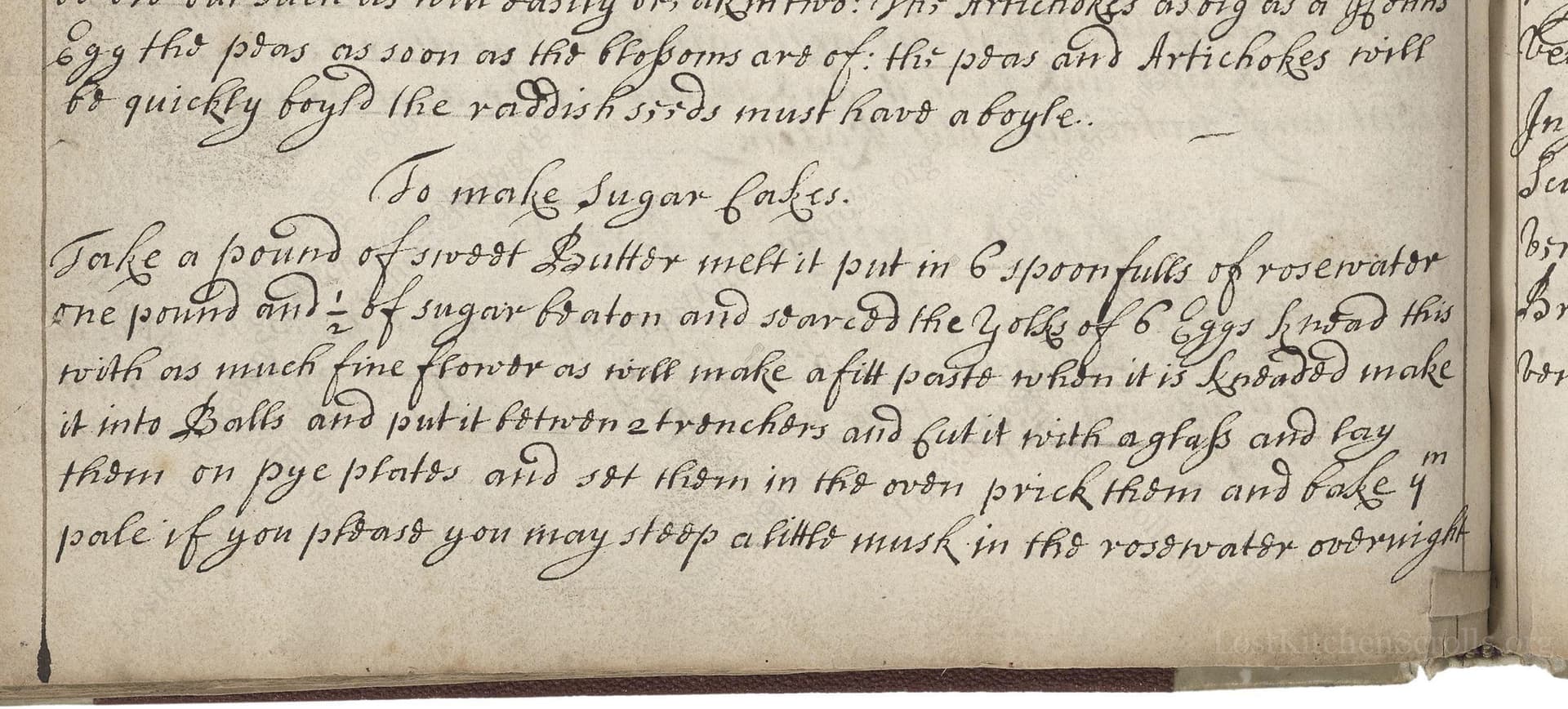To Make Sugar Cakes
From the treasured pages of Receipt book
Unknown Author

To Make Sugar Cakes
"Take a pound of sweet Butter melt it put in 6 spoonfulls of rosewater one pound and 1/2 of sugar beaten and searsed the yolks of 6 Eggs knead this with as much fine flower as will make a stiff paste when it is kneaded make it into Balls and put it between trenchers and cut it with a glass and lay them on pye plates and sett them in the oven prick them and bake ym pale: if you please you may stoop a litle musk in the rosewater overnight"
Note on the Original Text
The recipe is written in the conversational and unpunctuated style typical of housewifely manuscripts of the 17th century. Spelling is phonetic and certain terms ('searsed' for sieved, 'flower' for flour, 'trenchers', 'prick ym') reflect period usages. Directions were meant to be interpreted by experienced cooks, omitting precise oven temperatures and relying on practical judgement—what today we’d call 'bake until pale'. Ingredients like musk point to luxury and opulence, while the flexible use of flour shows an expectation of hands-on dough work.

Title
Receipt book (1687)
You can also click the book image above to peruse the original tome
Writer
Unknown
Era
1687
Publisher
Unknown
Background
A charming culinary manuscript from the late 17th century, brimming with recipes that blend hearty tradition and a dash of Restoration-era flair. Perfect for those seeking a taste of historic feasts and flavorful ingenuity.
Kindly made available by
Folger Shakespeare Library
This recipe hails from a late 17th-century English manuscript, dating between 1679 and 1694—a time when sugar was a prized, expensive luxury and exotic aromas like rosewater and musk were hallmarks of elite confections. Sugar cakes such as these would have graced banquet tables for special occasions, embodying opulence and intricate craftsmanship. The use of trenchers (wooden plates) for shaping reflects both the culinary tools and the social dining customs of the Restoration period, when shared, decorative sweetmeats were in vogue.

In the original kitchen, you’d find a hearth or brick oven for baking, wooden trenchers for flattening and shaping the dough, a glass or similar vessel used as a cutter, large mixing bowls, and pricking forks. The ingredients were measured by eye or by utensils like wooden spoons, and fine flour was sifted through a sieve by hand. Butter would have been melted over the fire, and rosewater, perhaps infused overnight with musk, would be added for unique fragrance.
Prep Time
25 mins
Cook Time
18 mins
Servings
36
We've done our best to adapt this historical recipe for modern kitchens, but some details may still need refinement. We warmly welcome feedback from fellow cooks and culinary historians — your insights support the entire community!
Ingredients
- 1 pound (16 oz) unsalted butter, melted
- 6 tablespoons (3 fl oz) rosewater
- 1.5 pounds (24 oz or 3 cups) caster sugar, sifted
- 6 large egg yolks
- 6 to 7 cups (about 1.5–1.75 pounds) plain wheat flour (approximate, enough to make a stiff dough)
- Optional: a small pinch of musk, infused in the rosewater overnight
Instructions
- Begin by melting 1 pound (16 ounces) of unsalted butter, allowing it to cool slightly.
- Stir in 6 tablespoons (about 3 fluid ounces) of rosewater.
- Next, blend in 1.5 pounds (24 ounces or 3 cups) of fine caster sugar, previously sifted to remove lumps, and the yolks of 6 large eggs.
- Gradually add as much plain wheat flour as needed (approximately 6 to 7 cups or 1.5 to 1.75 pounds) to create a stiff, kneadable dough.
- Once well mixed, divide the mixture into balls about the size of walnuts.
- Place each ball between two sheets of parchment paper (substituting for 'trenchers', or wooden plates), flatten gently, and use a small glass to cut neat rounds.
- Arrange them on baking trays lined with parchment and prick each lightly with a fork.
- Bake in a moderate oven (around 325°F) until pale golden.
- For an added authentic touch, you may infuse the rosewater with a pinch of musk overnight before use, though this is optional.
Estimated Calories
190 per serving
Cooking Estimates
Preparation takes about 25 minutes, including melting the butter, mixing the dough, and shaping the cookies. Baking takes around 18 minutes per batch in a moderate oven. Each serving contains about 190 calories, and this recipe makes around 36 cookies.
As noted above, we have made our best effort to translate and adapt this historical recipe for modern kitchens, taking into account ingredients nowadays, cooking techniques, measurements, and so on. However, historical recipes often contain assumptions that require interpretation.
We'd love for anyone to help improve these adaptations. Community contributions are highly welcome. If you have suggestions, corrections, or cooking tips based on your experience with this recipe, please share them below.
Join the Discussion
Rate This Recipe

Den Bockfisch In Einer Fleisch Suppen Zu Kochen
This recipe hails from a German manuscript cookbook compiled in 1696, a time whe...

Die Grieß Nudlen Zumachen
This recipe comes from a rather mysterious manuscript cookbook, penned anonymous...

Ein Boudain
This recipe comes from an anonymous German-language manuscript cookbook from 169...

Ein Gesaltzen Citroni
This recipe, dating from 1696, comes from an extensive anonymous German cookbook...
Browse our complete collection of time-honored recipes



